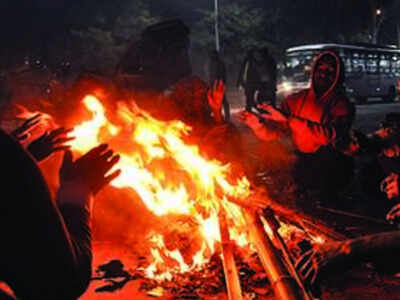
PATNA: Sunny days notwithstanding, night temperature is likely to remain below 10 degrees C in Patna and most parts of the state this week as well.
Patna Meteorological Centre claimed that though weather is expected to remain dry, cold westerly winds coming from the snow-laden Himalayan peaks will keep the mercury in night and early morning hours below 10 degrees C at least till February 13. The daily weather bulletin issued by Patna Meteorological Centre on Sunday afternoon stated that fall in night temperature is expected by two to four notches over Bihar during the next 24 hours.
An extended weather bulletin on February 6 stated that minimum temperatures are likely to be in the range of 9 to 13 degrees C till February 13.
Even on Sunday, the minimum temperature at Patna stood at 8.4 degrees C, which was three notches lower than the corresponding normal. Gaya remained the coldest place in the state in the morning with minimum temperature at 6.8 digress C.
“The cold northwesterly winds will continue to blow in the region, keeping a check on rise in minimum temperature till February 15. Maximum temperature is, however, expected to be in the range of 23-25 degrees C till then owing to the clear skies allowing warming up of lower level of atmosphere due to direct solar rays,” an official at Patna Meteorological Centre said.
He said dry weather prevailed and shallow fog was observed at one or two places over the state during last 24 hours.
Meanwhile, a western disturbance is very likely to affect western Himalayan region from February 11 onwards. Met officials, however, ruled out any significant impact of the upcoming western disturbance on the prevailing weather in Bihar.
“Any western disturbance henceforth will not have much impact on weather in Bihar, in terms of significant rainfall or variation in temperature,” the meteorologist said.
The western disturbances are low pressure area or extra-tropical storms originating from Mediterranean Sea, Red Sea and Caspian Sea, which cause snow and winter rainfall in north-western Indian subcontinent. Normally, there are six to seven western disturbances in January, but meteorologists claimed this time there were around 10 such weather systems and most of them affected Bihar.
Patna Meteorological Centre claimed that though weather is expected to remain dry, cold westerly winds coming from the snow-laden Himalayan peaks will keep the mercury in night and early morning hours below 10 degrees C at least till February 13. The daily weather bulletin issued by Patna Meteorological Centre on Sunday afternoon stated that fall in night temperature is expected by two to four notches over Bihar during the next 24 hours.
An extended weather bulletin on February 6 stated that minimum temperatures are likely to be in the range of 9 to 13 degrees C till February 13.
Even on Sunday, the minimum temperature at Patna stood at 8.4 degrees C, which was three notches lower than the corresponding normal. Gaya remained the coldest place in the state in the morning with minimum temperature at 6.8 digress C.
“The cold northwesterly winds will continue to blow in the region, keeping a check on rise in minimum temperature till February 15. Maximum temperature is, however, expected to be in the range of 23-25 degrees C till then owing to the clear skies allowing warming up of lower level of atmosphere due to direct solar rays,” an official at Patna Meteorological Centre said.
He said dry weather prevailed and shallow fog was observed at one or two places over the state during last 24 hours.
Meanwhile, a western disturbance is very likely to affect western Himalayan region from February 11 onwards. Met officials, however, ruled out any significant impact of the upcoming western disturbance on the prevailing weather in Bihar.
“Any western disturbance henceforth will not have much impact on weather in Bihar, in terms of significant rainfall or variation in temperature,” the meteorologist said.
The western disturbances are low pressure area or extra-tropical storms originating from Mediterranean Sea, Red Sea and Caspian Sea, which cause snow and winter rainfall in north-western Indian subcontinent. Normally, there are six to seven western disturbances in January, but meteorologists claimed this time there were around 10 such weather systems and most of them affected Bihar.
Trending Topics
LATEST VIDEOS
City
 AAP set to retain Delhi, third term for Kejriwal, predict exit polls unanimously
AAP set to retain Delhi, third term for Kejriwal, predict exit polls unanimously  Delhi CM Arvind Kejriwal hits out at Smriti Irani, says women decide their family vote
Delhi CM Arvind Kejriwal hits out at Smriti Irani, says women decide their family vote  Three-storey building collapses in Punjab's Mohali, several feared trapped
Three-storey building collapses in Punjab's Mohali, several feared trapped  I thank police for arresting AAP worker who used abusive language against me: Alka Lamba
I thank police for arresting AAP worker who used abusive language against me: Alka Lamba
More from TOI
Navbharat Times
Featured Today in Travel
Get the app





